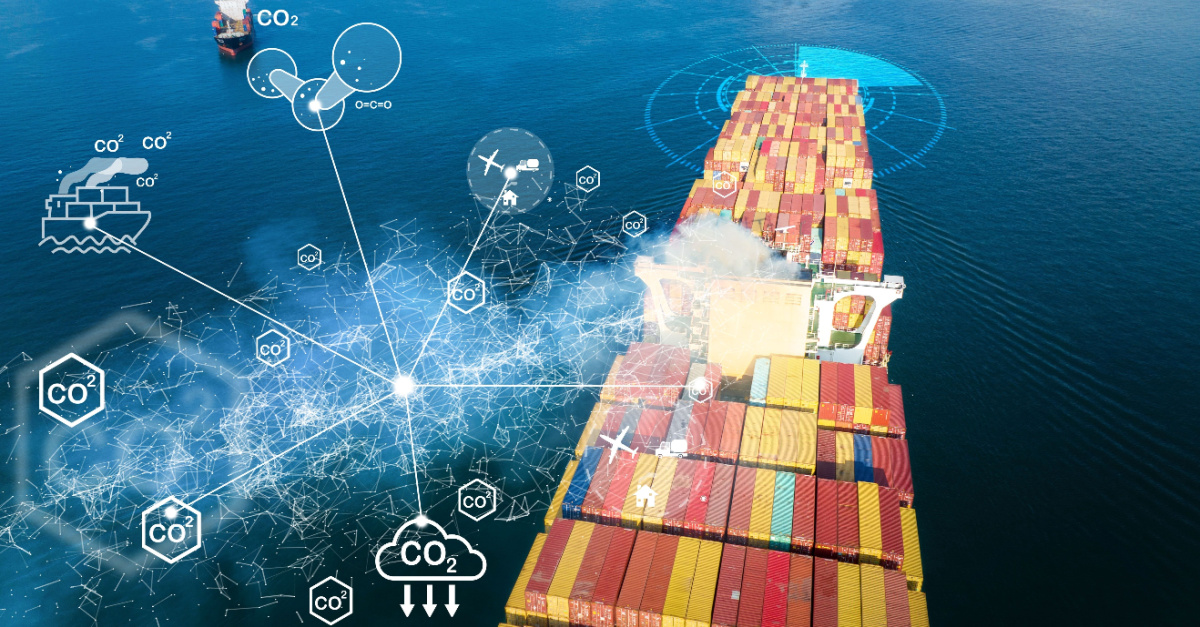
In an era of heightened environmental awareness, the global logistics landscape is witnessing a significant paradigm shift as regulatory bodies tighten their grip on supply chain emissions. As nations rally behind initiatives like the Paris Agreement, the call for sustainable practices resonates louder than ever. Against this backdrop, regulatory frameworks such as the International Maritime Organization’s (IMO) CXII, the European Union Emissions Trading System (EU ETS), and the California Air Resources Board (CARB) are taking center stage, imposing stringent mandates on the reduction of greenhouse gas emissions within the supply chain.
Shippers find themselves under mounting pressure to navigate this evolving regulatory landscape. The urgency to align with emission reduction mandates, often accompanied by the threat of penalties for non-compliance, prompts a critical evaluation of existing operational models. It’s not merely a matter of compliance; it’s a strategic imperative for businesses seeking to future-proof their operations and contribute to global decarbonization efforts.
As regulators tighten their scrutiny, shippers are turning to technology to streamline their emissions management. Greenabl, recognizes this urgency and offers guidance and assistance with a platform to help shippers seamlessly measure, mitigate, and offset CO2 emissions from their transportation supply chains, while offering transparent and data-driven methodologies for both direct and indirect carbon emissions.
Today’s Shippers Face an Increasingly Stringent Regulatory Landscape
In the rapidly evolving realm of supply chain emissions, shippers find themselves navigating an increasingly intricate regulatory landscape. As governments worldwide intensify their commitment to environmental goals, the pressure on industries to reduce their carbon footprint has never been more pronounced. Here, we delve into three pivotal emissions regulations shaping the shipping industry in 2024 and explore how these regulations are compelling shippers to overhaul their strategies for a greener future.
1. IMO CXII (Carbon Intensity Indicator)
The International Maritime Organization’s (IMO) Carbon Intensity Indicator (CXII) stands as a beacon for environmental accountability in the shipping industry. As of the latest regulations, rules on shipping’s carbon intensity and a rating system have come into force, mandating comprehensive tracking and assessing vessels’ emission levels. Shippers must now grapple with the dual challenges of maintaining operational efficiency while adhering to stringent carbon intensity indicators.
The requirements stipulate that vessels must carry a valid Carbon Intensity Indicator (CII) certificate, showcasing their commitment to reducing emissions. This certificate is a tangible reflection of a ship’s performance, offering transparency to stakeholders and authorities. Compliance obligations are rigorous, forcing shippers to adopt innovative solutions beyond mere regulatory compliance.
2. EU ETS (Emissions Trading System)
The European Union’s Emissions Trading System (EU ETS) has extended its reach to the maritime sector, ushering in a new era of accountability for shippers. While laudable in its environmental goals, the ‘historic’ decarbonization deal within the EU ETS introduces complexities for shippers. The potential inflation of future shipping rates looms large as the industry grapples with the economic implications of this ambitious agreement.
Shippers must now engage in meticulous monitoring, reporting, and verification processes to align with EU ETS requirements. The spotlight on emissions places a premium on transparency, forcing companies to adopt technology-driven solutions that provide real-time tracking and data analytics. Greenabl, with its cutting-edge platform, emerges as a strategic partner for shippers seeking to navigate the intricate web of EU ETS regulations.
3. CARB (California Air Resources Board)
On the other side of the globe, the California Air Resources Board (CARB) wields influence with its Advanced Clean Fleets Rule. The state’s recent decision to hold off on permitting only new zero-emission vehicles in the drayage registry adds a layer of complexity to compliance for shippers. CARB’s extraterritorial application poses challenges for global shipping, requiring a nuanced understanding of regional regulations.
Shippers operating within and beyond California must now balance compliance with CARB’s stringent rules while maintaining efficient and cost-effective operations. As shippers strive to align with CARB’s evolving standards, technology-driven solutions like Greenabl emerge as the cornerstone for success in an era of heightened regulatory scrutiny. Greenabl’s cooperative procurement approach becomes invaluable in such scenarios, offering a seamless exchange platform for navigating the intricate landscape of CARB regulations.
As Regulators Demand Accountability, Shippers Turn to Technology
In the face of mounting regulatory pressure, shippers are turning to technology as the linchpin for achieving transparency and accountability in their emissions reduction efforts. The imperative to meet stringent standards set by regulatory bodies like IMO CXII, EU ETS, and CARB has spurred a technological revolution within the shipping industry.
The link between compliance and cutting-edge technology becomes apparent as shippers seek to not only meet regulatory requirements but also streamline their operations for sustainability.
As the regulatory landscape continues to evolve, technology-driven solutions are not just a strategic choice but a necessity for shippers aiming to thrive in a future where environmental stewardship and operational efficiency are inseparable.
Greenabl, with its comprehensive 360-degree technology platform, emerges as a beacon for shippers navigating this complex terrain. Real-time tracking, data analytics, and pragmatic solutions for sustainable logistics operations become essential tools in the arsenal of shippers striving to reduce their supply chain emissions. With its proven cooperative procurement approach, platforms like Greenabl stand at the forefront, empowering shippers to leverage technology in their quest for lower supply chain emissions. Here are some benefits of tech platforms like Greenabl for carriers and shippers:
1. Emission Monitoring Systems for Maximum Accountability
In the pursuit of accountability, shippers are embracing advanced monitoring technologies to track and report emissions in real time. Greenabl’s platform takes center stage in this arena, offering real-time emissions tracking and reporting solutions that seamlessly align with regulatory requirements.
Such tech platforms become crucial allies for businesses seeking to achieve regulatory compliance without the burden of manual reporting. By streamlining environmental reporting and providing accurate, timely data, tech platforms like Greenabl empower companies to navigate the complexities of emissions regulations effortlessly.
2. Data Analytics for Efficient Operations
The role of data analytics in emissions reduction cannot be overstated. Shippers are leveraging data-driven insights to optimize routes and operations, thereby enhancing fuel efficiency and reducing overall emissions. Greenabl, with its robust data analytics capabilities, becomes a strategic partner in this endeavor.
The platform analyzes key operational data, identifying opportunities for efficiency improvements. Armed with actionable insights, businesses can make informed decisions that align with sustainability goals and optimize fuel consumption and overall environmental performance.
3. Pragmatic Mitigation for Actionable Sustainability
Tech solutions like Greenabl provide invaluable support through its team of consultants for shippers, carriers, 3rd party service providers, importers, and exporters. These experts guide members in understanding practical operational solutions for emissions reduction. What sets Greenabl apart is its commitment to implementing these solutions to mitigate supply chain emissions without imposing significant financial burdens or disrupting networks.
The platform ensures the seamless integration of sustainability solutions, striking a delicate balance between effective emissions reduction, minimal financial impact, and network disruption. With a pragmatic approach, Greenabl guides organizations in adopting eco-friendly practices, aligning their supply chains with regulatory standards without compromising operational efficiency or incurring excessive costs. As shippers face the dual challenge of meeting regulatory demands and maintaining profitability, Greenabl emerges as a strategic ally, ushering in a new era of technology-driven sustainability in the logistics industry.
Navigating a Sustainable Future with Greenabl’s Technological Edge
This escalating regulatory landscape demands a paradigm shift in how shippers approach supply chain emissions. Moreover, the demand for accountability is driving a transformative wave of innovation, with advanced monitoring technologies, data analytics, and pragmatic mitigation strategies emerging as essential components for sustainability.
Greenabl, with its state-of-the-art technology platform, emerges as the catalyst for this transformation. Offering real-time emissions tracking, data analytics for operational efficiency, and pragmatic mitigation strategies, Greenabl stands as the epitome of innovation in sustainability.
As shippers must comply with stringent regulations, the cooperative procurement approach, demand aggregation platform, and expert consultancy services provided by Greenabl position businesses to thrive in a greener future. Embrace technology and achieve accountability—contact Greenabl today to lead the charge in lowering supply chain emissions and driving sustainable operations.

